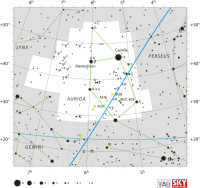
Photo from wikipedia
The most powerful tests of stellar models come from the brightest stars in the sky, for which complementary techniques, such as astrometry, asteroseismology, spectroscopy, and interferometry can be combined. The… Click to show full abstract
The most powerful tests of stellar models come from the brightest stars in the sky, for which complementary techniques, such as astrometry, asteroseismology, spectroscopy, and interferometry can be combined. The K2 Mission is providing a unique opportunity to obtain high-precision photometric time series for bright stars along the ecliptic. However, bright targets require a large number of pixels to capture the entirety of the stellar flux, and bandwidth restrictions limit the number and brightness of stars that can be observed. To overcome this, we have developed a new photometric technique, that we call halo photometry, to observe very bright stars using a limited number of pixels. Halo photometry is simple, fast and does not require extensive pixel allocation, and will allow us to use K2 and other photometric missions, such as TESS, to observe very bright stars for asteroseismology and to search for transiting exoplanets. We apply this method to the seven brightest stars in the Pleiades open cluster. Each star exhibits variability; six of the stars show what are most-likely slowly pulsating B-star (SPB) pulsations, with amplitudes ranging from 20 to 2000 ppm. For the star Maia, we demonstrate the utility of combining K2 photometry with spectroscopy and interferometry to show that it is not a 'Maia variable', and to establish that its variability is caused by rotational modulation of a large chemical spot on a 10 d time scale.
Journal Title: Monthly Notices of the Royal Astronomical Society
Year Published: 2017
Link to full text (if available)
Share on Social Media: Sign Up to like & get
recommendations!